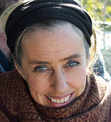Georgi Y. Johnson's Blog: I AM HERE - Opening the Windows of Life & Beauty, page 25
October 21, 2016
Beyond the Horizon – What Happens When we Die?
Death. The core idea that fuels a perennial sense of condemnation. Whether we do good, or whether we do bad, anyway we die. Whether we succeed or whether we fail, anyway we die. Whether we are world famous, or whether we a random point amid 7 billion flickering faces, anyway we die. It’s inevitable. It’s a certainty. It’s entirely unavoidable. Yet anyway we invest vast amounts of energy in the attempt to avoid, or deny it. Why?
Please don’t be afraid.
Death is a word loaded with terror and pain. The association of helplessness and loss can be so extreme that we build battalions of belief and superstition to circumvent that naked, formless ‘threat’. These include beliefs about transformation, heaven, one-ness, consciousness and more. A belief is a belief.
Death is Now

“Death is very likely the single best invention of Life. It is Life’s change agent. It clears out the old to make way for the new.” Steve Jobs
Experientially, living insight into death is available now, as there is no other time. Our future death is now. Our past deaths are now. In the moment, we are already, also ‘dead’.
It could sound shocking, but that is only because we forgot who we are. The subtle quest for concepts, notions, and transcendental stories can support us in meeting the inevitable, but will not replace the inevitable. The inevitable reveals that all that could die within us, and all that can never die, is present at the source of you, in this instant.
Just as every possible configuration of time depends on the timeless, so does the very concept of death depend on the deathless.
All that comes into being comes to pass, this is the nature of form. Yet that which never becomes, or passes, proliferates and is inseparable from every moment of consciousness and each second of experience – of any nature.
The fear of death is more generated by a survival anxiety around aspects of form or hidden personality that we don’t want to experience. In an attempt to block our worst nightmare, we unconsciously create a casing of resistance. Both the resistance and the nightmare will come to pass, but we will not.
The source of all we are – and of the timeless dimension of consciousness that witnesses our bodies as children transforming into adulthood and old age – doesn’t itself age and doesn’t pass with (human) time.
Nothing Happens
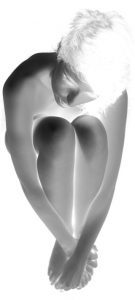
“The fear of death follows from the fear of life. A man who lives fully is prepared to die at any time.” Mark Twain
Death doesn’t ‘happen’. Death is a cessation of ‘happening’.
Through out your physical life, you can witness every happening in the inner and outer worlds of experience. Stuff moves, comes, goes and changes. The happening itself depends on your witnessing it. Yet you are not the happening.
Through all stages of physical or psychological transformation, there is happening. Yet between the milliard spaces in every action and re-action, we are still here, as a persistent presence. This deeper source of ourselves can be revealed when we agree to refrain from grasping or pushing away, and just let the happening happen. In death, the clarity revealed through the cessation of ‘doing’ brings a freedom to be even more your self – not the self with qualities, agendas, likes and dislikes -but the deeper self behind and before that.
Physical movement and activity, psychological holding and rejection stops happening. Where there was noise, there is silence. Where there was light, there is darkness.
That which was the great receiver of physical sensation, in a manner revolves inwards. The organs of sense perception close down and what remains is that which has always been behind them – the infinite receiver of the information of sense perception. Yet sensing doesn’t entirely stop, as experience was never totally dependent on its physical machinery. We also have inner senses and inner feeling, inwards, towards the universal source. This sensory field revolves into the dominant sensory field, as the physical senses of the body close down.
We implode, deeply into the source of who we (all) are.
Death is Here

“While I thought that I was learning how to live, I have been learning how to die.” Leonardo da Vinci
In a similar manner, location becomes liberated of habitual mental and physical frames. We don’t go anyway (we were always ‘here’). We simply expand more deeply into the ‘here’. Here becomes boundless, beyond any concept of threat.
There is no ‘other’. In death, there is the collapse of the gross sense of ‘otherness’.
Although we’re programmed to believe that death is a transition to another space, a better place, another dimension or another universe. Even if we believe that death is the end (non-existence is as the ultimate concept of ‘other’), in death we truly don’t go anywhere.
You can check it now. Are we ever somewhere other than where we are? When we travel the body, or when we change experience in our mind or heart, are we not always, undeniable still ‘here’?
Death is not elsewhere. Perception changes, and the windows of perception transmute, but we actually expand into the core of here. We’re not going anywhere ‘else’.
The Miracle

In death only the body dies. Life does not, consciousness does not, reality does not. And the life is never so alive as after death.” Nisargadatta Maharaj
For a short space of physical time, we inherit a body and mind which grows through its own cycles and completes them. This body-mind is a great Window of perception into this dimension. Every moment of consciousness, each wave of awareness, every understanding beyond duality, each felt experience of the energies of feeling and emotion, is a marvel of manifestation. Each second is a tiny sampling of the physical miracle within the endless of ocean of stillness and peace.
For better or worse, physical life is precious, but it’s not private. It always was and will always be an inextricable part of the its own source, inseparable from it’s own negation, perpetually participating through the whole.
The death-less way is also the way which allows the transformation of death to take place within the vast, unfettered expanse of a much deeper source of who we are, beyond even intimacy, at the depth of the living.
It truly is OK.
October 20, 2016
Trauma Tunnels – 7 Ways to Find Peace
Many have written saying they feel that traumatic states and contractions are so many and so pervasive, that they seek all help possible to get free. Feeling caught in old trauma or PTSD – especially when the cause can’t be found or doesn’t seem to justify the response – is indeed a living hell that can hijack our lives and by default, that of our families. Following are some insights that could support a deeper movement into peace.
Periods of depression, fear, negativity, rage, despair, dread – these are physical phenomena recognized by all of us. At times, background states of suffering can suddenly flip to the foreground and it seems to be only through distraction into something ‘pleasant’ that we’re able to drive them back inside.
In cases of trauma, a set of triggers – often our unique sensitivities involving our worst nightmare (that which must never happen) – can launch us through a rabbit whole into a separate universe of the traumatic state. It’s bleak in there. Although a traumatic rabbit hole can feel self-righteous, truthful (in a bitter way) and temporarily empowering, it’s lonely and blocks both receptivity and expression. We are unable to take in information, and expression feels almost shameful.
1.Be Mindful
 Awareness of inner suffering is perhaps the most critical aspect of healing. Just the inner recognition of negative feelings, pain, resentment or stress creates space in the inner world. Awareness of feelings and emotions brings care towards the dissonant energy fields. The agreement to experience them, without too much commentary from the mind, brings the care for which this energy longs.
Awareness of inner suffering is perhaps the most critical aspect of healing. Just the inner recognition of negative feelings, pain, resentment or stress creates space in the inner world. Awareness of feelings and emotions brings care towards the dissonant energy fields. The agreement to experience them, without too much commentary from the mind, brings the care for which this energy longs.
Of all the mindfulness exercises, breathing in the present moment and breathing out the past is perhaps the most useful for trauma. This is because whatever is cramped in feelings and emotions is the effect of the past. It belongs to the past. The in-breath offers a freshness of the taste of the air and the living presence of the movement of the body. The out-breath offers release. It can be noticed that negative emotions all almost indistinguishable on the in-breath, and with the out breath they are released with the old air. That gives us a break with every in-breath of presence.
Trauma often affects our breathing – we tend to breath more shallowly the more stressed we become, or even hold our breath. As such, it can be helpful to put greater emphasis on the out breath. Blow out as if you were blowing out through a straw. Let the in-breath come naturally, of itself.
In training like this, you will find that the healing breath becomes unconscious – the moment a suffering becomes triggered, sometimes even before the mind has got a hook. It can even carry on loving you though states of sleep, where an enormous amount of healing takes place.
2.Radical Acceptance

Form is empty of a separate self, but it is full of everything in the cosmos. The same is true with feelings, perceptions, mental formations, and consciousness.
Thich Nhat Hanh
We all want to be free of trauma, that is, we would like to get rid of it. This drive to reject the trauma, by healing it out of existence, is actually echoing the same movement through which the trauma was created in the first place. A rabbit hole of trauma is part of our energetic experience that has been amputated from the whole, cut off from our ‘normal’ experience. Tragically, this severance was often aided and abated from family and society around us that couldn’t contain our suffering. This split in the psyche, after that, is maintained by an agenda to keep it out of sight; to hide it from the outer world and if possible from our own consciousness. As such, the agenda to get rid of trauma has the power accentuate the split, or create further splits in other directions, as we design a trauma-free form for ourselves and others.
The situation that created the trauma happened. It can’t be undone. It happened. Healing comes not through eradication of the past, but through the adding of time and space to the experience to the degree that the trauma no longer defines who we are, and no longer determines our direction in life.
As part of trauma involves the social field, it can be tremendously helpful to learn how to communicate trauma to others in certain contexts. This doesn’t have to be a drama. It can be a relaxed statement that you’re sensitive in that area, or a genuine admission that you’re experiencing a traumatic memory right now, and would rather take some time to relax. Remember, the charged emotions that cause you to feel the trauma is socially unacceptable don’t need to be expressed (that can make the sense of rejection around the trauma worse), just the request for another’s respect towards the pain in that moment. These small communications create bridges between that inner, taboo zone and the outer world. Also they immediately alleviate secondary degrees of isolating fear, guilt and shame around the trauma zone. They are precious.
3.That Dreadful Strength
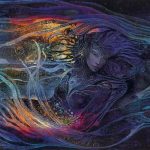 When a trauma or severe shock occurs, there is a rip in the fabric of time and space our of which our habitual ‘normal’ reality is composed. The experience doesn’t fit the collective mind, it leaves us for a while hovering outside of time and in no clear location. This sense – of existing beyond the consensual fabric of reality – has a sharp truthfulness about it. It feels more ‘real’ than the sleep-state around us. It is deeply empowering because it has this incredible sense of inner truth.
When a trauma or severe shock occurs, there is a rip in the fabric of time and space our of which our habitual ‘normal’ reality is composed. The experience doesn’t fit the collective mind, it leaves us for a while hovering outside of time and in no clear location. This sense – of existing beyond the consensual fabric of reality – has a sharp truthfulness about it. It feels more ‘real’ than the sleep-state around us. It is deeply empowering because it has this incredible sense of inner truth.
In trauma, this severance in the trance of habitual reality can adorn the traumatic universe itself with a feeling of deeper truth or ultimate reality. All the suckers out there are drinking tea and eating cake, but “I” know suffering. “I” know death. “I” know that the tea and cake will end in tears.
This sense of truth, combined with the hidden power of the incredible self righteous victim carries and emotional charge and can actually function as a retreat position for some from failure in the more superficial aspects of life. “Don’t mess with me,” are Private Detective told me once, when I threatened to sue his company for stalking me, “I’ve been in the war in Lebanon.” “Don’t mess with me,” I replied, smiling, “I’ve hung out many nights in Brixton.”
The secret reward of exemption from normal social rules can lead to a subconscious abuse of the trauma and a subtle agenda to keep it in the armory of protection against life and the living. The use of greater past pain to de-throne some discomfort in the present can be a short term fix that spirals between lesser and greater suffering, rather than the healing movement of deep surrender to feeling the feeling, which can lead to integration.
Radical acceptance of the traumatic happening means that we are able to hold it in experience in such a way that we can offer it to the universe, to a higher power, or to the greater consciousness. This offering can only be made through our permission to experience the energy. There is no bypass.
4.Slow Motion, Little Pieces

“Since at any point of time and space I can be both the subject and the object of experience, I express it by saying that I am
both, and neither, and beyond both.”
Nisargadatta Maharaj
As stated above, the agenda to get rid of trauma completely and all at once can reinforce the traumatic split, rather than facilitate a reintegration of frozen energy into the whole. Moving very slowly with our consciousness towards the feeling, or memory and staying each time, just a little bit longer, can be tremendously supportive in deeper healing.
In addition, the sampling of little pieces, rather than the whole ‘event’ has an effect of realization. It’s enough just to take one detail of chronological and/or experiential memory, and to stay there with patience and curiosity.
The often mono-tonal repetition of the “story” can be a verbatim way to wall the rabbit hole of trauma way from direct experience. Be inquisitive. What shoes were you wearing? What color were the walls? How did the air smell in that moment. What sounds could be heard.
By taking just all the time to experience just a little detail of a trauma, we begin to bring it back to the land of the living – the only movement it ever needed.
5.Alternating Universes
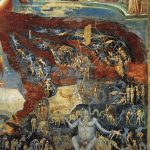 This one can take some practice. When you find yourself down the rabbit hole, try to consciously drop it (this is not repressing it, but disengaging for a moment). Move to another position with your consciousness where you feel happy. It can be the pleasant feeling of the air on the face, or you could stroke your own shoulders lovingly and enjoy that caress. You could even think of something or someone that makes you happy. Stay in the better place just long enough to get the experience of it. Then go back to the rabbit hole. Experience the rabbit hole, just for a while, then go back again to the pleasant space. This kind of alternation between perspectives can be radically liberating, building a trust and consolidation in the living awareness that is here, irrespective of the nature of experience. This ability to oscillate brings a new mastery and greater freedom within our inner world, unlocking the instinctive freeze/flight/fight responses of fear.
This one can take some practice. When you find yourself down the rabbit hole, try to consciously drop it (this is not repressing it, but disengaging for a moment). Move to another position with your consciousness where you feel happy. It can be the pleasant feeling of the air on the face, or you could stroke your own shoulders lovingly and enjoy that caress. You could even think of something or someone that makes you happy. Stay in the better place just long enough to get the experience of it. Then go back to the rabbit hole. Experience the rabbit hole, just for a while, then go back again to the pleasant space. This kind of alternation between perspectives can be radically liberating, building a trust and consolidation in the living awareness that is here, irrespective of the nature of experience. This ability to oscillate brings a new mastery and greater freedom within our inner world, unlocking the instinctive freeze/flight/fight responses of fear.
6.Expansion is Generous
 When we feel love or happiness, we tend to naturally allow it to expand to be shared with others. When we suffer however, we often fear that this “bad” energy could hurt others, that it could infect the world. As a result, we energetically contract. This contraction also involves shielding our suffering with an inexpressive face of pretended behaviors of being “OK”. Think of when you’ve really been hurt by a lover, and they ask what’s going on. “Nothing,” is often the automatic response.
When we feel love or happiness, we tend to naturally allow it to expand to be shared with others. When we suffer however, we often fear that this “bad” energy could hurt others, that it could infect the world. As a result, we energetically contract. This contraction also involves shielding our suffering with an inexpressive face of pretended behaviors of being “OK”. Think of when you’ve really been hurt by a lover, and they ask what’s going on. “Nothing,” is often the automatic response.
There is a depth of misconception here. There is beauty in open suffering, and the authenticity of emotion, even when it is sadness, pain or fear. The natural response of others in feeling the purity or nakedness of this energy is care. People react badly to pretense. They feel shut out. When others are allowed, even energetically, inside our naturalness, the response tends to be either loving care, or considerate space. Don’t be fooled into believing that shrinking your truth into the background is protecting someone else!
7.Suffer for the Whole
 You might not have heard about inherited trauma and the legions of research that is affirming that psychological trauma, traumatic patterns and PTSD can be passed down through our genes from one generation to another. Integrating even a little piece of trauma within yourself is a tremendous service to all your family.
You might not have heard about inherited trauma and the legions of research that is affirming that psychological trauma, traumatic patterns and PTSD can be passed down through our genes from one generation to another. Integrating even a little piece of trauma within yourself is a tremendous service to all your family.
In addition, the frozen energy of fear, anger or despair of a traumatic contraction is not your private property. It’s human energy from the shared human field. It effects others whether or not you want it to. It creates a resonance of suffering on the planet, even before we begin acting out from our traumas and perhaps causing still more suffering for others.
Each particle of pain we process individually is of service to the whole. Dedicating the experience of suffering (when it is here) to others – to suffer it if possible on behalf of others – is tremendously worthwhile. It can even create an expansion that means we are able to invite added volume. If you suffer a fear of abandonment, for example, take into your heart a child that has been abandoned, whether or not you know them, and suffer this pain also for them. Suffer for others in worse situations than yourself – be there for them, with them.
This movement again bridges the rift between the habitual universe and the traumatic one. It undoes isolation, and opens the heart towards the whole, and also towards the last one we always forget, ourselves.
My fear is always in relation to the known, not to the unknown.
~ J. Krishnamurti
October 18, 2016
The Healing Power of Time and Space
Years ago, in the physical wilderness of anxiety and panic attacks, I remember lying down, desperately immobilized on the wooden floor boards of our house. I had pain to the sides of my chest and around my hips. On top of hardly being able to breath, it felt like I was physically dying. I brought my frightened consciousness to the pain and began to feel it, checking it out. Then the unexpected happened, it moved to another location. It was alive in itself without a direct anchorage (yet) in the physical.
This was kind of amazing, as I had been so much ensnared in thought, memory, imagination and agenda of the mental variety, that I had never thought to check out the apparent randomness of physical sensations. If someone had told me that this was the start of a whole healing journey (rather than a private, superstitious inquiry) it could have helped a lot. This is the reason for this post. Consciousness is a healer. Where we limit our consciousness in time and space, denying it access to our somatic experience, we are denying our forms the greatest gift of all – universal care – from the inside out.
 Right now, tune in to any physical feeling below the head and above the legs. Stay there for a while experiencing it with all the time and all the space. Does it move? Change temperature? Change location? Does it throw you away so that suddenly you find yourself thinking urgently about something random? Yes. The body is alive, and this is an energetic phenomena or contraction responding to the healing presence of conscious awareness.
Right now, tune in to any physical feeling below the head and above the legs. Stay there for a while experiencing it with all the time and all the space. Does it move? Change temperature? Change location? Does it throw you away so that suddenly you find yourself thinking urgently about something random? Yes. The body is alive, and this is an energetic phenomena or contraction responding to the healing presence of conscious awareness.
Consciousness – the harbinger of eternity, and awareness, the doorway to the infinite are in commonplace terms, the very substance of time and space.
Do you recognize the feeling of not enough time and not enough space, either internally, or in relation to a beloved? This is the experience of contraction, and sooner or later, it has to release.
Whether it is in the freeze of depression, in which energy stagnates with a solidity around the chest, or in the broken, spitting cables of nervous anxiety, something is dissonant – out of rhythm with the body and environment. Just as the stomach cramps with hunger, or the flesh seizes up around an open wound, our feelings and emotions contract when there is a difficulty processing experience in real time and in physical context. Sometimes we need to contract – such as an urge to laugh at the mother-in-law, but often we stay contracted and that’s when our very experience of life loses vitality.
Contraction – meaning a withdrawal of connection from our own bodies, from our friends and a closing of receptivity or expression into the world – involves a conditioning of time and space. Each form – even our own body – is an equation of time and space.
Stress – whose purpose is to help us survive – is the activator of contraction. The chief signature of stress is a feeling of ‘no time, no space.’
No time or space for what? No time or space to take care of what is emerging in the here and now.
Relaxation returns the sense of unlimited time and space, and when we relax, we begin to open up, as do our contractions. Even relaxing the body – really giving it permission to surrender into peace (rather than relaxing into habitual states of stress), has an energetic effect of emotions, feelings and thought.
Unwinding Time
 We are programmed to live through the misconception that time is given to us from the outside: it’s in limited supply and it’s forever running out. We feel ourselves to be victims of this kind of time and experience a pressure to shrink into rationed portions of relaxation.
We are programmed to live through the misconception that time is given to us from the outside: it’s in limited supply and it’s forever running out. We feel ourselves to be victims of this kind of time and experience a pressure to shrink into rationed portions of relaxation.
Feelings, emotions, grief, love, happiness, joy – this is all down-rated – as a kind of recreational indulgence stolen from this obligation of ‘time’ – which demands that you become ‘someone’ and do ‘something.’ Caught in this belief, we increasingly find ourselves ‘doing time’ as a life experience: waiting, expecting, anticipating the reward that will come – later – when time lets us go.
At the same time, this release from time is terrifying, as it can only mean death and an isolated banishment into the wilderness of all we have always been running from: the end of who we think we are. We are taught to survive life until we die, mentally programmed to run ever faster away from death, towards death (and this is ‘sanity’).
For many, a paradigm shift comes with the awakening to the nature of time. Time is non-existent in the way we have been programmed. Past and future are ideas living in the present moment: past and future are functions of memory in the here and now, and imagination in the here and now. They are inseparable from this moment.
The past is alive in the present, which means that in the present moment, we can give the past the care that it lacked – exactly in that area of contraction in feeling or body. We can give time back to the experience, where it was robbed of time. Time in its essence is better described as a living eternity.
Contractions from grief, trauma or subtle states of depression will wait forever until this kind of time sets them free – until the presence of this living eternity alive at our source allows them to transform. This means we can actually heal past situations in the present moment. Let’s say you did something nasty towards someone you love, and this causes you shame. In this present moment it is possible to touch the energy of the living memory and to give what it lacked – the regret, the acknowledgement of a mistake, the insight of how it played out, and above all the deeper connection which is always alive beyond any human entanglement. If we ourselves were injured, revisiting the pain in this present moment and touching the situation with care, has the power to unravel the web of cause and effect that led to the injury: it opens the possibility of forgiveness. In this way, we are able to liberate the contractions within ourselves, but also to transform the memory of the event to a wider, wiser understanding. Does it effect the others, whether dead or alive? If we change half of a drawing from 2d to 3d, isn’t the whole drawing altered?
In the same way, through opening the present moment, we can feel into our future, which greatly deepens and clarifies decision making process that could otherwise seem to be unconscious, vaguely intuitive and indecisive. In this moment, we can take ourselve to the same present moment in a possible future context. Either we are already there, now, or we find that, well, it’s not meant to be. 
October 16, 2016
Consciousness as a “Window” – Science Affirms Passive Frame Theory
Where does thought come from? If we actively choose not to think of something, is the thinking happening anyway, whether or not we are conscious of it? Are whole processes of understanding and formulation taking place way beneath the precincts of our conscious mind? If so, then who or what is choosing the content of contemplation?
It is hard to live in an environment of fear, and to not have either fearful thoughts, or fight/flight strategies emerging in our head. It is hard to be consciously shown images of petrol driven cars, without the word ‘car’ registering in consciousness. Before we know it, we’re buying one.
A new study led by San Francisco State University researcher Ezequiel Morsella concludes that this same automatic effect can occur with much more complicated mental manipulations – for instance, transforming “car” to the pig latin “ar-cay” in your head even after you’ve been told to avoid that transformation. Consciousness, the study indicates, is a conduit of information, but it neither creates nor selects the information in itself.
Morsella compared consciousness to a format like the Internet. “If you’re arguing with someone over the internet, you need the internet,” he said. “By itself, consciousness, like a window, doesn’t actually do that much… but what it provides for other, more active (and unconscious) systems is essential.” This approach affirms ancient wisdom that sees the brain as an organ of perception, an inherited, magnificent processor, through which the energy of consciousness flows. As an organ of perception, the brain is both a receiver of content and a transformer. Consciousness, as the power supply, exists independently – it is neither generated by the brain nor dependent on it.
The research suggests that the window of consciousness can either be open, closed, or filtered, but regardless of the window, the light still shines. The contents of consciousness (defined here as the state of being awake and aware of our surroundings) are the creation of the physical form and the environment. They are often generated involuntarily, says Morsella.
In fact, the study published in the journal Acta Psychologica provides the first demonstration that even a small amount of training can cause unintentional, high-level symbol manipulation. “Our study reveals that unintentional, unconscious processes can be more sophisticated than what has been thought before,” says Morsella.
What is conventionally called ‘waking consciousness’ is just the tip of the iceberg of a consciousness that far exceeds the boundaries of the personal self or the physical body or individual mind, according to new scientific research. The findings are in alignment with the premise of the book I AM HERE that suggests that what is classically called waking consciousness is a window of perception, differing from the sentient window of awareness, and the unfiltered window of perception through emptiness. Yet the energy revealed through all three windows is entirely independent of the ‘waking’ state of mind or body.
“The brain is an organ of consciousness, which is entirely dependent on degrees of receptivity in finding form.”
Morsella said the study provides more support for the passive frame theory that he proposed along with his colleagues last year, a potentially groundbreaking idea that suggests consciousness is more of a conduit for information in the brain rather than an active creator of information. The theory has generated a significant amount of attention in academic circles and in the popular media, and Morsella said his team has written a follow-up paper to the study that will be published in an upcoming issue of the journal Behavioral and Brain Sciences. “Consciousness is passive, and that its contents are often generated ‘unconsciously’. But [consciousness] is necessary,” he stressed. (Note: don’t get distracted by the word ‘passive’ – it could also be more powerful and more intelligent than anything the we could conceive from the perspective of science).
The findings could also be helpful for clinicians looking for ways to treat patients beset by unhealthy obsessive thoughts or ruminations, or compulsions, Morsella noted.
At the same time, the research indicates the ongoing confusion in world-views regarding consciousness – both semantically and philosophically. The lack of consensual definition of the word ‘consciousness’ and how it sits with the word ‘life’ (which doesn’t depend on ‘human’ waking consciousness) is apparent to all who have receded into the wonders of consciousness empty of content through meditation or other avenues.
This confusion can be easily clarified when we thoroughly let go of the notion that the brain is somehow the creator of consciousness, and instead allow the ample evidence that as part of the physical body,the brain is an organ of consciousness, which is entirely dependent on degrees of receptivity in finding form within the wider context of the physical dimension.
The next inquiry could be: is consciousness only a conduit of information, or is it at the same time inseparable from the phenomena appearing out of itself? What is needed for greater well being? Could it not be the relativization of all content, through the allowance of the limitless expanse of unfettered power apparant through consciousness itself? Can the mind surrender its beliefs in the significance of content to the consciousness which power its very existence?
“Involuntary symbol manipulation (pig latin) from external control: Implications for thought suppression” by Ezequiel Morsella and Hyein Cho (San Francisco State University), Pareezad Zarolia (University of Denver) and Adam Gazzaley (University of California, San Francisco) was published online in April 2016.
Nonduality and the Release of Control, Conformity and Convention
For Alice, an inner sense of security depends on the people around her. She needs them to conform to a certain code of behavior in order for her to feel safe. Her partner must kiss her before she goes to work (regardless of whether he feels like it or not); the children must sit at the table and show appreciation for the food (regardless of whether they are actually enjoying it); and others – from shop keepers, to cleaners, to colleagues – must show her respect, regardless of what they are feeling inside. The world, however, is a rebellious, nasty place. It constantly insults her with disobedience, and because of this, she feels weak, threatened, unseen and constantly under threat.

Pure perception without discrimination
Alice’s perception of reality is actually the 21st century civilized norm. It assumes that the individual has the power to dictate experience on others. It sees the creative power of consciousness, and creates for itself a tight shell of isolation, where the world ‘out there’ – is full of nasty surprises and murderous freedom.
One morning, Alice explodes on her partner. “But I gave you a kiss!” protested her shocked partner. “Yes,” Alice snapped back, “But you didn’t mean it.”
In a psychological universe where we believe we can dictate content with form, or grasp the soul of ‘the other’ by locking it in a box of fixed behaviors, we will always be defeated. As our teacher Bob Moore once said, “Love is a force that cannot be controlled. You can only blend with it.”
Controlling Thought forms (Consciousness)

Conformity as a transient survival strategy
On the level of the dialectical mind, our thoughts are forms born out of an impetus of feeling. Most often, this sentient impulse is fear. Fear says: “beware” and the mind tries to find the threat in order to make safe. Fear says: “not good” and the mind finds all the negative aspects of the object in perception in order to justify the feeling. Fear says “pain” and the mind gets to work finding elaborate tactics to avoid the pain, including denial, distraction and/or destruction of the ‘other’.
Our thoughts are sources in our feelings and emotions. As such, the agenda to be free of the endless torture of a busy mind must allow a falling out of conscious control of thoughts into the ocean of sentience. Feelings and emotions, in all their subtle shades, come in many flavors, forming a kind of soul to the thought form, energizing it and determining direction.
We can try and ‘think’ ourselves into loving another person, for example, but if the love is not arising spontaneously out of the magic of connection, the project will fail, sooner or later.
Within the first moment of a thought (for example, when we think of another person), there is clear, nondual perception. Then, our discriminating mind sets in and judges – good, bad, like, dislike, want, don’t want – when this splitting begins, we have lost clarity, and an opportunity to flower in this moment as a fully embodied human being.
Within the silence of mind we are liberated from the control of our thoughts.
Emotional Conformity (Awareness)

The other side of a peacock’s show.
When we allow ourselves to attend to our feelings and emotions – beyond and before the formulation of thought – we expand from consciousness to awareness and move into a deeper layer of causality.
Feeling our feelings is not a mechanical act. It is pure sensitivity, which refines and clarifies the more we use it. Be curious, move slowly and with softness. What is the flavor of this feeling? It’s painful, but how is it painful? Is it active or frozen? Does it have a color, a taste? Is it only the feeling we thought it was, or are there other emotions around it too?
At first we might just meet anger, followed by fear, followed by pain. The art is not to let the story take up the cause. Caring for these energetic forms of feeling and emotion beneath our thoughts – giving them time, space and our loving presence – is essential. As we let the movement of feelings live in our awareness, they can unfold to deeper and increasingly familiar background atmospheres of how it feels to be alive.
Within the stillness of heart we are free from the conformity of our felt sense.
Physical Convention (Emptiness)

The body as an evolving, intelligent part of the physical universe.
In the evolutionary play between mind and heart, we are blessed with the nondual container of the body. Whether we are entangled in our thoughts or gasping through the pain of emotional attachment, the body stays. As such, the body offers the first and most undeniable tool to coming to peace. When the thoughts become senseless and destructive, bring the attention to the feet on the ground, to the inbreath and outbreath, blessing this moment of life. When feelings seem to sweep is away like an incoming tide. Breath though them, attending to the miracle of the physical sensation of breath. Even if only for a few seconds, this can set the feelings free to move where they need to go.
The body is not a dead thing, nor is it the enemy. Our cells tell the collective history of the whole universe. The oxygen moving through our lungs and carried through our blood is pure energy – neutral and free of the burden of the shape and size of any form, be it physical, emotional or mental. The more we can learn to rest in the rhythms of the body, which are naturally attuned to the rhythms of the whole physical dimension, the more we come to peace. The more we come to peace, the less we are afraid of life, including physical life and physical death.
We have a miraculous and unique opportunity to experience being consciously aware in physical form, as an inseparable part of physical manifestatoin. Let’s not reject it before enjoying each shade of its living experience. In becoming one with the body, we also move a layer deeper to the causal core of emotions and feelings. Even in the cells of our body, our genes are affected by the defeats and suffering of our ancestors. It is for us to set them free.
Stress triggers fear and anger. It arrives out of the experience of separation from the universe outside of ourselves. This came about out of an instinctive drive towards individual survival. It’s triggers are peppered throughout the most subtle layers of our living body to protect us, yet when stress becomes the underlying engine of all our endeavours (even when no physical threat is present), it becomes tremendously destructive towards the whole.
The more we are able to relax into stress, relax around stress, to find comfort regardless of stress, the less we are caught in a perpetual cycle of self-defeat, in body, feeling and thought.
Within the emptiness of the body, we are liberated from the convention of death.
Alice
Sooner of later Alice is going to surrender to the world that is appearing within her consciousness, without censorship and control. Life itself will demand it. The dictatorship of the mind, like all dictatorships, will fail, as the pure energy of life takes back the form for the sake of the whole. Softly, silently and sometimes with the most ferocious love, she will bring Alice home.
Sentient Sourcing – Healing Inherited Trauma. London April 8, 2017
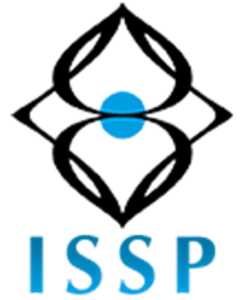
Sentient Sourcing – Healing Inherited Trauma
With Spiritual Psychologists Bart ten Berge and Georgi Y. Johnson
London Art Therapy Center, Kings Cross, London
Saturday April 8, 2017
9:30 am – 5:30 pm
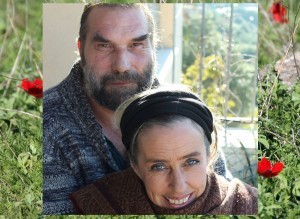
Bart ten Berge & Georgi Y. Johnson
That sudden depression, this irrational anxiety, a pervading dread of betrayal or abandonment, a sense of unconditional guilt, that has been there for as long as you can remember. Repeating, uncaused sentences in the back chambers of our thoughts – “they’ll lock me up”, “I don’t belong here”, “I want to kill myself”.
A central premise in Nondual Therapy is that the barrier between our ‘private’ thoughts, feelings and states, and the collective, is far more porous than we have been taught to believe. The energy of the thoughts and feelings that form us is embedded all the way down to the cellular level of our bodies, and it effects our experience of freedom, love and peace in our lives, with a potential to distort our perception, direction and ability to express into the world.
This one day intensive workshop is designed to offer the tools of sentient sourcing. Deepening and expanding layers of mindfulness towards both thoughts and feelings – how it feels to be ‘you’. Working with sentient sourcing, Bart and Georgi will offer exercises to experience and identify core states of stress and survival that could have been inherited through the traumas and/or lived experience of our ancestors. As these feelings become sourced, they become conscious and the opportunity emerges to release subtle layers of identification with states of suffering. The effect is liberating, often with the reward of hidden qualities that have been repressed and that are released through the process of nondual realization.
Bart ten Berge and Georgi Y. Johnson are co-founders of the International School of Spiritual Psychology (ISSP) based in the Netherlands. In conjunction with the movement’s vision of bridging allopathic and alternative wisdom through energy healing and inner growth, they are pioneering the field of Nondual Therapy – a paradigm shift in care for the individual as an inextricable part of the whole. For a list of background resources, see below.
A number of slots for private sessions with Georgi and/or Bart are available at the Center at discounted rates for participants on the evenings of Friday 7th and Saturday 8th April. To book a session, contact info@iamhere.life
Venue:
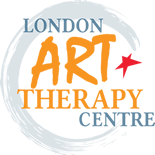 London Art Therapy Center, Kings Cross, London
London Art Therapy Center, Kings Cross, London
Pionner House, 46 Britannia St., London WC1X 9JH
Tel: 020 34899192
Cost:
$220 – Standard full day training
$180 – Students, low income & participants of i-Exist 2017 Retreat in Glastonbury*
Select
Standard $220.00 USDStudents/ Low Income $180.00 USD

*a number of scholarships are available, please apply to info@iamhere.life
Resources and Background Reading
It didn’t start with you, Mark Wolynn (Book)
The Breadcrumb Trail of Inherited Family Trauma
The Parents we Never Knew: Adoption & Family Trauma
Set my People Free: Nonduality and the Epigenetics of Trauma
An Introduction to Nondual Therapy
October 3, 2016
SET MY PEOPLE FREE – Nonduality & the Epigenetics of Trauma
Our genes form our personalities. But often, the rejection of the personality as ‘illusory’ is a repeat of an old formula of spiritual bypass and self abnegation. What does it take to awaken into spiritual freedom? Often the release of prosaic, peculiar drudgery of suffering we could have believed was with us for ever.
 Scientific research is revealing how our ancestors’ traumatic childhoods or heroic adventures can form our personalities. We are formed in the most subtle dimensions through our ancestors – for better or worse – and most often both.
Scientific research is revealing how our ancestors’ traumatic childhoods or heroic adventures can form our personalities. We are formed in the most subtle dimensions through our ancestors – for better or worse – and most often both.
From a nondual perspective, the freedom to be able to experience freedom, can itself be affected through subtle dimensions of our physical bodies. As such, a realization as remote as sourcing our own suffering in that of a grandparent, can be the game-changer that sets the ‘person’ free of attachment.
At the core of every cell of our body – at the resonant center of the experience of being alive – there are locks. The keys to open these locked are uniquely formed by the psychological history, not only of the individual, but of all the ancestry out of which the individual is composed. The key has the opposing shape of the lock it is destined to open. Our symptoms are precisely the form needed to open the lock of our suffering.
These genetic dimensions are so tiny – the nano-scale tags that trigger contraction or evolution of a particular genetic code – that they are highly resonant, meaning a change in vibration (for example, a relaxation in an area of historic stress), can have a healing impact for generations – literally relieving genetic contractions and affecting neural networks. And when who we thought we were – often for our whole lives – collapses, there opens a great opportunity for awakening as the light of pure existence seeps through the cracks in the wall of pre-established identity.
Following are some pointers from nondual therapy.
1. Sentient Sourcing
A central theme of nonduality is the release of the belief in a separate self. This ‘self’ is not just a mental concept, or an identity, it is an experience. The realm of felt experience is always in the present moment. The only way we can check in on a feeling is by feeling it.
Even when we remember a feeling, we are feeling it again. Feeling collapses linear time. It is resonant, not rational. As such, the energetic forms of feeling and emotion present in our ancestors are passed onto us and equally present in us, seeming to be intimately our own. They live outside of gross physical time. The only possibility to release the voltage is transformation – for example, from fear to freedom, from jealousy to compassion. This transformation occurs when the unconscious patterns pass through the threshold of consciousness – when they are experienced fully and expressed, not as personal identity, but as phenomena in flux.
This means the sourcing of the core layers of attachment arises through unconditional awareness. It involves a radical acceptance of whatever moods, feelings or sentient patterns come forward, as nothing more (and nothing less) than a physical legacy.
It also means that locating the area of contraction in the physical body, and laying a loving hand there, can be as directly effective as talk therapy. Also here, there is a resonant effect through the healing touch of consciousness.
2. Who am I?
We feel ourselves to be a certain way. We experience deep attitudes, fears or yearnings which can feel old and familiar to us – almost as if they were universal. In this, we make our inner affliction absolute, at the same time as guarding it as an intimate layer of who we are. Yet true freedom requires no watch-dogs. It can’t be threatened or taken away.
The defensiveness and the fear of intimacy itself suggests a threat, and a threat suggests fear. Fear is only present where loss is possible. If loss is possible, then illusion is present. The source of all we are as living beings can never be lost. It can never be lost because there would need to be a deeper one we would call a loser. No loser, no loss. The loser stays and is beyond all loss.
3. It’s not only trauma
While the extreme cases and population groups come under the microscope of epigenetics, the inheritence of states of being, attitudes, and whole formulas of action and reaction are not limited to traumatic events. Inherited atmospheres, patterns, attitudes and even figures of speech express and reaffirm the inner landscape. Often, they are so repeated through family structures that they can appear as absolute. “That’s just the way it is.” The very possibility of seeing blue sky is obliterated by a pervasive fog, so much so, that even when freedom is present in startling clarity, it’s not recognized, or rapidly forgotten.
Often after a nondual awakening, there can be a crash into these background atmospheres, as if the survival of the personality itself depends on the sustenance of the limited form.
Notice a family with a negative attitude towards life, or a surrendered attitude towards the institution of marriage (as an unavoidable kind of slavery), or a deep suspicion of strangers. All this is a reflection of a sentient layer of personality, passed on and affirmed blindly through the family system and through generations.
4. The Common Themes of Ancestral Trauma
The complexity and diversity of accumulating trauma through the generations can be enough to drive us out of identification with the human endeavour and to step sideways into existential freedom. Yet the healing remains to be done – calling us consistently and creating and recreating scenarios that confront us with our inner states and limitations again and again.
In this, it can be helpful to realize that all trauma melts down to just a few collective themes. Often, inherited trauma involves at least two of these playing out at once (eg. abandonment and death).
These themes can be put forward as:
Poverty: Poverty is traumatic, terrifying and a daily suffering. The reality of physical insufficiency from history is today reflected in the pervading sense of lack among populations where basic needs are easily fulfilled. Many of our grandparents are directly impacted by the threat or experience of tremendous poverty between two world wars and a great recession.
Death: The collective repression of the subject of death indicates an enormous difficulty with the acceptance physical death, especially when it is not within the norms of a long life. The repression directly impacts grief processes, intensifying fear and isolation. The impact of witnessing death in war time is no less traumatic than in peace time.
Rejection: Imprisonment; banishment to an institution (orphanage, psychiatric); emotional disconnection from the mother; rejection on political or racial grounds. The agony and trauma of rejection is directly linked to the belief in a separate self, and breeds and affirms belief in the separate self, severing an individual from inner and social resources.
Sexuality: Rape, incest, betrayal, abandonment, shaming, social condemnation, suspicion, jealousy or rage towards the ‘other’ sex.
Abuse: Abuse takes many forms, including spiritual abuse and substance abuse. The experience of abuse involves two actors in the dynamic: perpetrator and victim. This means that it is often the inner abuser that is most repressed and most alive beneath the mask of daily life. Ironically, much abuse takes place through the assumed form of the victim. Unhealed trauma around abuse can be expressed through abusive, self-righteous behaviour, or self abuse – in which both abuser and victim are internalized.
Illness: Illness can bring up many of the other afflictions – such as death, poverty, rejection and abuse. This can light up the whole structure of medical intervention and disease in a manner that acts out with obsession.
Despair: Lifetime disapointment; existential despair; collapsed dreams; the impossibility of fulfilling the individual promise or bringing heaven to earth, within the exclusive zone of an individual or a life time. Unlike the former afflictions, despair is not linked with the instinct to survive in separate form, but is of a deeper dimension – the dark night of the soul – that can run through life times.
5. Too Much Trauma
When we open the inner doors, allowing our total inter-being with our ancestors, it can be startling how much of our personality is formed by trauma. It can seem endless. In this, a deep allegiance to the source of unbounded awareness in which all experience arises is critical. All form is broken. They are all chiseled out of the rock. Destruction shapes them. But in the end, they are only forms – thought forms, forms of sentient experience, forms of expression – they are not who we truly are.
Wherever there is depression, anxiety, contraction or compulsion, there is trauma in the background – if not directly our own, then that of our ancestors. No form is free of trauma. Yet we do have the chance to open up a whole new freedom in attitude and perspective
In the present moment, in any space, we have the possibility to bless our eyes, ears and feet on the ground, and inhale the unrestrained, living mystery of the beauty of life all around us. Here, there is both a choice and a tremendous resource for healing. Breath in the fresh air or the NOW, breath out the past. Even the simple act of mindful breathing can reveal the stages in the process of transformation.
“Out of this new fluidity, we are no longer enslaved in a predetermined personality, but rather, the personality begins to work for us – as an expression of the tremendous beauty of life living itself.”
The beauty of allowing our core states and reflexes into awareness is that we gain freedom. This freedom is not only in the realization of our true source as living, indestructable joy, but also in the opportunity to manifest freely as human. Our ability to directly channel this joy into the world becomes greatly increased – as the mental, emotional and physical limitations to manifestation are removed.
The realization that many of our core sufferings are not ‘ours’ at all is tremendously liberating. It removes the added contractions of shame, guilt, or the sense of being inherently ‘bad’. It dissolves the sense of isolation (isolation often experienced directly within family settings), through reconnecting the heritage of the generations. In addition, each contraction is a contraction of something – something positive – a human quality or potential, or an area of freedom. The release of identification and attachment to these subtle forms opens a vast expansion of possibility.
Relieved of the burden of being an isolated and failed ‘person’, the form of the person becomes a service that we live though, for the sake of our ancestors and our children. In this new fluidity, we are no longer enslaved in a predetermined personality, but rather, the personality begins to work for us – as an expression of the tremendous beauty of life living itself. All we need to do is allow it.
October 2, 2016
Who Am I? Nonduality Gets Personal
Perhaps the most important question we will ever ask ourselves is: “Who am I?”
On inquiry, the answer won’t be found in identity, but through an unfolding of inner mystery.
Identity is fragile – it depends on a deeper source that is able to identify with anything – a source much closer to the truth of who we are. Identity is a garment that changes, evolves, and sometimes falls away in the unconfined freedom of the present moment.
The question Who am I? is a koan. When we feel into it, deepening occurs: not in where we believe ourselves to be separate or different, but within the tremendous simplicity of being here, alive. The answer is not a thought, but an experience.
The more we remember who we are, the more what we thought we were evaporates.
This is a sacred disappearance: the vanishing of limitations on our freedom; the falling away of the stress of sustaining the facade of a separate self; and the release of the burdens that load the mental concepts of success and failure.
On inquiry, much of this suffering of being ‘someone special’ is ensnared in the confines of time and space.
Today, it’s known that even the deeper layers of so-called unique personality – our inner states and stress responses – are actually inherited with our bodies. The form which we believed ourselves to be is composed, in the words of Thích Nhất Hạnh, entirely by “non-you elements.” Our body is changing and predetermined. Our personality is inherited from our forefathers. Our moods resonate with our environment.
So what is left? Who am I? The answer – arising from the gut of life in this moment, right here – can open the doors to freedom.
Three Questions
The classical question is Who Am I? This is a question of the mind – a tunnelling into the entangled and often conflicting labels of temporal self identity.
As we begin to immerse our consciousness into the sentient, boundless zone of the heart, however, another question comes forward. Here, in the realm of love and contraction, the question becomes What Am I? What am I made of? What is this substance of feeling? What is able to feel even beyond thought or speech? This is the shift from consciousness (head) to awareness (heart).
The third question involves a sinking deeply into the bones of the body and the physical matter of the body. This is the dimension of perception through emptiness, in which all that passes with time, and all that is confined within space is seen as transient, passing and non absolute. In this dimension, the very notion of borders – of the absolute separation between one entity and another – dissolves. Here, the question is ‘Where Am I?” Where, in the most inner, truthful center is this “I” located? Where does it begin and where does it end?
These three layers of inquiry have a powerful potential to liberate the “I” from the illusion of limitation. Out of this freedom, the suffering of the human psyche reverses and the ‘I’ is liberated to move with pure, unconditional, natural alignment through the causal layers of time, space and form.
No-thing gets left out.
THIS EDEN – Georgi Y. Johnson
THIS EDEN
Spiralling under fixture
Of mind or heart
Or second-hand fables
With close and a start.
This steadfast, wild,
inconquerable Eden,
That no one can hold,
That’s never foretold.
Witless to the tired,
Human burden
Of lies and shame,
(that plastic, dark,
Fantastic game).
Just four legs exalting
Valley and wood,
As Eden moves through,
Undividing and good.
Yes, I was muddied in mind.
I lost the moment for time
Of the suffering kind.
But here she waits,
As if we were never taken.
Blissful Eden, the earth
Of the unforsaken.
September 24, 2016
The Parents we Never Knew. Inherited Family Trauma & Adoption
What if I’m adopted? Please help me understand.
In several online venues, where the subject of generational trauma – trauma inherited from our parents and ancestors – has been discussed, the question has been raised: what about adoption? How should someone who has never known their biological parents make sense of this?
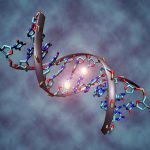 The legacy of family trauma is topical right now, partly due to the discovery of gene alteration through epigenetics. Epigenetics is the study of changes in organisms caused by the modification of gene expression rather than alteration of the genetic code itself. It all began earlier this decade as scientists discovered that certain odours with a traumatic history would trigger a stress response in rats of succeeding generations. Science later revealed the traumas of World War II are showing up in the genes of holocaust descendants. “Instead of numbers tattooed on their forearms. they may have been marked epigenetically with a chemical coating upon their chromosomes, which would represent a kind of biological memory,” reported a paper in 2013. Research has shown that stress-based restrictions of the gene resource can pass through both mother and father. In 2016, scientists from Tel Aviv University addressed the open question: can this genetic damage be corrected? Yes, they answered, there is a high chance that healing the trauma in the living descendant, will remove the epigenetic tag, meaning it’s no longer passed on.
The legacy of family trauma is topical right now, partly due to the discovery of gene alteration through epigenetics. Epigenetics is the study of changes in organisms caused by the modification of gene expression rather than alteration of the genetic code itself. It all began earlier this decade as scientists discovered that certain odours with a traumatic history would trigger a stress response in rats of succeeding generations. Science later revealed the traumas of World War II are showing up in the genes of holocaust descendants. “Instead of numbers tattooed on their forearms. they may have been marked epigenetically with a chemical coating upon their chromosomes, which would represent a kind of biological memory,” reported a paper in 2013. Research has shown that stress-based restrictions of the gene resource can pass through both mother and father. In 2016, scientists from Tel Aviv University addressed the open question: can this genetic damage be corrected? Yes, they answered, there is a high chance that healing the trauma in the living descendant, will remove the epigenetic tag, meaning it’s no longer passed on.
Nature V Nurture
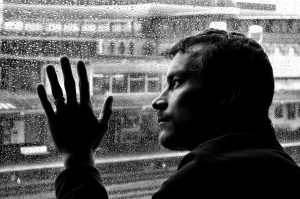 The emergence of research on trauma and epigenetics opens a whole new challenge in the debate of Nature V Nurture. Actually, one of the reasons we have carried the notion for so long that our inner moods, stress reactions and sensitivities are individually unique is because it has been hard to distinguish what is emanating from our cells, from what it is repeated through our family environment in terms of conditioning. A family that carries a line of distress around the threat of insanity, for example, will have its avoidance programmed not only into the body, but also into its internal language. At a very early age, children from such a family will hear the threat of “going crazy” as a threat of a fate worse than death. Psychologists would rarely scrape the surface of the fears of the immediate environment in order to delve into a trauma from a few generations before (in which the judgement of insanity could have been experienced as a kind of existential death to the family).
The emergence of research on trauma and epigenetics opens a whole new challenge in the debate of Nature V Nurture. Actually, one of the reasons we have carried the notion for so long that our inner moods, stress reactions and sensitivities are individually unique is because it has been hard to distinguish what is emanating from our cells, from what it is repeated through our family environment in terms of conditioning. A family that carries a line of distress around the threat of insanity, for example, will have its avoidance programmed not only into the body, but also into its internal language. At a very early age, children from such a family will hear the threat of “going crazy” as a threat of a fate worse than death. Psychologists would rarely scrape the surface of the fears of the immediate environment in order to delve into a trauma from a few generations before (in which the judgement of insanity could have been experienced as a kind of existential death to the family).
Yet in the case of an adopted family, the stress signals (whether physical, emotional or verbal) of the adopted family are not necessarily matching the stress signals of the body of the adopted child. This can have a palliative effect, as the distress signals are not provoked, excited or endorsed. Yet at the same time, there can be a dissonance with adopted parents and a sense of difference that seeks resolution. This is could be especially true as the circumstance that lead to a mother giving her child up for adoption are more often than not traumatic in themselves.
In utero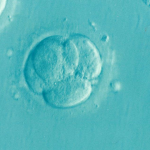 As pioneer of transpersonal psychology Stanislav Grof points out, traditional psychology begins in late infancy. It hardly addresses the first days of life and the birth experience, let alone the nine months in gestation. Spiritual psychology and nondual therapy views the experience in utero as fundamental to the formation of inner states (the first impressions on physical awareness), as well as on the programming of stress responses. The baby is in a union with its mother’s body, floating within and nurtured by the amniotic fluid which carries the whole biochemistry of the mother. This biochemistry includes stress hormones, as well as the biochemistry of pleasure, pain, comfort and relaxation. When the mother is experiencing an emotional contraction, or the anguish of isolation or loneliness, the unborn child shares these moods and already learns to recognize these patterns on a biological level.
As pioneer of transpersonal psychology Stanislav Grof points out, traditional psychology begins in late infancy. It hardly addresses the first days of life and the birth experience, let alone the nine months in gestation. Spiritual psychology and nondual therapy views the experience in utero as fundamental to the formation of inner states (the first impressions on physical awareness), as well as on the programming of stress responses. The baby is in a union with its mother’s body, floating within and nurtured by the amniotic fluid which carries the whole biochemistry of the mother. This biochemistry includes stress hormones, as well as the biochemistry of pleasure, pain, comfort and relaxation. When the mother is experiencing an emotional contraction, or the anguish of isolation or loneliness, the unborn child shares these moods and already learns to recognize these patterns on a biological level.
A mother carrying a child, that for whatever reason already knows she will be separated from that child after birth, is giving a particular series of chemical signals to the unborn baby. One key frequency is one of confusion, as the instincts on the body to keep the unborn baby alive and safe conflict with the bond of love and the beliefs of the mind. The movement of fear behind the decision to surrender the child can be contracted by the added fear that if the feeling is allowed, it will be impossible to disconnect.
In terms of inherited trauma, there is a possibility that the mother’s situation is itself a repetition of events in her own family where a baby was surrendered. In this, the child is the sacrificed one, which then becomes the gift to the adopted family. He or she literally bridges two systems. As such, the theme of helplessness, rejection, loneliness and difficulty in bonding (universal themes in themselves) are likely to come forward with amplification. As a contra to this, there might be a passion for unity, nonduality or inner exploration to answer the great mystical question: “Who am I?”
Genetics: from gross to subtle.
 In cases of adoption, any physical peculiarity, such as a weakness in the kidneys, or left-handedness, that doesn’t match the adopted family’s history is likely to be put down to the biological lineage. In many ways, inherited trauma is no different. Pioneer of inherited trauma and family constellations Mark Wolynn reports on a case of a girl who was adopted:
In cases of adoption, any physical peculiarity, such as a weakness in the kidneys, or left-handedness, that doesn’t match the adopted family’s history is likely to be put down to the biological lineage. In many ways, inherited trauma is no different. Pioneer of inherited trauma and family constellations Mark Wolynn reports on a case of a girl who was adopted:
Melissa, from a happy, privileged background with no visible trauma, began cutting herself as a teenager. When she was 14, she literally carved the words “FAT PIG” into her inner thigh. Bewildered, the loving parents sought help, but there seemed no rational cause to the obsessive cutting. As the story unravelled, it turned out that Melissa was adopted, and was not told this until she was 21. She went to visit her biological mother and learned her mother had been violently raped when she was 14 (the same age that Melissa had carved the words ‘fat pig’ into her thigh), and this is how Melissa had been conceived.
“She visits her biological mother and she finds out that her mother, at exactly the same age, was raped. When Melissa came to me, she was 27 and had been cutting her body for 13 years. Just the chance to make the connection through therapy was enough to relieve Melissa of the tendency to self-harm which had begun at the same age that her mother had been raped and she was conceived. (Click here for the full interview in which Mark Wolynn discusses his work).
What if I know nothing about my parents?
 Even with those who grew up with their biological parents, the lack of information or knowledge that can no longer be retrieved often comes forward. While knowledge can be affirming and help release belief systems of personal identification with trauma, it is not the main point. The main point of nondual therapy, and the only way it is effective, is when we agree to honor and feel our own feelings. Feelings are energy in contraction. They are that raw material which determines the personality and direction we take in life. Feelings of affliction restrict our freedom of body, heart and mind. The liberation of such feelings involves allowing them to emerge: agreeing to experience them, within the vast tapestry of human possibility.
Even with those who grew up with their biological parents, the lack of information or knowledge that can no longer be retrieved often comes forward. While knowledge can be affirming and help release belief systems of personal identification with trauma, it is not the main point. The main point of nondual therapy, and the only way it is effective, is when we agree to honor and feel our own feelings. Feelings are energy in contraction. They are that raw material which determines the personality and direction we take in life. Feelings of affliction restrict our freedom of body, heart and mind. The liberation of such feelings involves allowing them to emerge: agreeing to experience them, within the vast tapestry of human possibility.
Family trauma has several key notes though. Although it might be echoed through memorable traumas in our life-time, we see the same themes repeating. Inherited trauma involves fears we have had for as long as we can remember: fears that are not necessarily shared by everybody else. When we watch a movie, or read a book, or hear a story, it is found in that aspect of the story, or that character, that incites our emotions, with whom we become entangled. It is that aspect of the plot with the most impact, that stays with us, long after the movie has finished.
Mindfulness of our own thoughts – especially the persistent undertones that return again and again – gives pointers to how we are coded. A thought, for example, that switches between subject and object “I’m going to kill you,” or “You’re killing me”, or “I’m going to kill myself”can reflect trauma around abortion, a child that was aborted or died before you were even conceived, or a desire to be free of a pregnancy. Our bodies, from a cellular, to an emotional, to a mental level, will show us the trail back to release the old wounding.
To be adopted
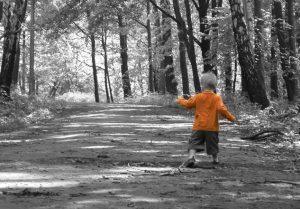 Even the phrase suggests the possibility of being ‘not’ adopted. There is a depth of beautiful in the soul-learning of being born into a life as an adopted child. There are lessons about separation and unity, about love, care, belonging and longing. There is a resonant key note of being irrevocably and unconditionally a gift to the whole – regardless of lineage – as a child of light and promise. The challenge is in finding peace in all forms according to what is needed by the whole, without losing the inner connection to the source of self, the greatest parent of all. The key wisdom is to totally, utterly and without any doubt allow that you belong here, beyond question, simply because you are here – an inextricable part of the whole.
Even the phrase suggests the possibility of being ‘not’ adopted. There is a depth of beautiful in the soul-learning of being born into a life as an adopted child. There are lessons about separation and unity, about love, care, belonging and longing. There is a resonant key note of being irrevocably and unconditionally a gift to the whole – regardless of lineage – as a child of light and promise. The challenge is in finding peace in all forms according to what is needed by the whole, without losing the inner connection to the source of self, the greatest parent of all. The key wisdom is to totally, utterly and without any doubt allow that you belong here, beyond question, simply because you are here – an inextricable part of the whole.
“The partner of rejection of acceptance.
Belonging has no opposite.
In belonging, acceptance and rejection are one.”
I AM HERE - Opening the Windows of Life & Beauty
- Georgi Y. Johnson's profile
- 30 followers


